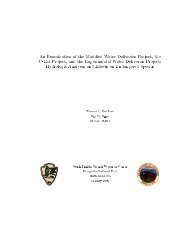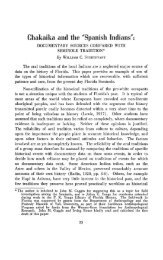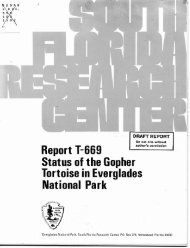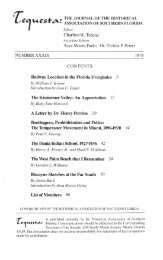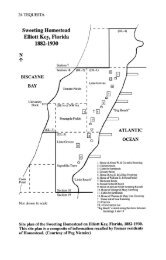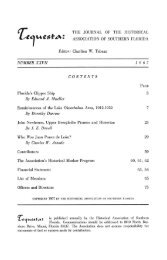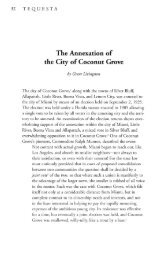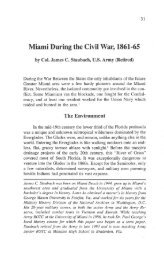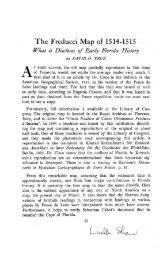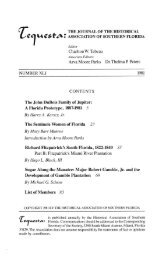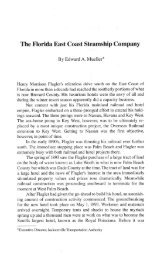Charles Torrey Simpson's Love Affair with South Florida - FIU Digital ...
Charles Torrey Simpson's Love Affair with South Florida - FIU Digital ...
Charles Torrey Simpson's Love Affair with South Florida - FIU Digital ...
You also want an ePaper? Increase the reach of your titles
YUMPU automatically turns print PDFs into web optimized ePapers that Google loves.
62 TEQUESTA<br />
Some came to pluck the flowers to sell for a profit. Others<br />
became enchanted by the area's unique natural richness and beauty<br />
and stayed to nurture and protect it. Fortunately for <strong>South</strong> <strong>Florida</strong>,<br />
one of the latter group was <strong>Charles</strong> <strong>Torrey</strong> Simpson, brilliant, selftaught<br />
field naturalist and gifted writer of a type that is almost extinct,<br />
who in 1905 moved to Lemon City, a few miles north of Miami, on<br />
Biscayne Bay. "I loved <strong>Florida</strong> on sight," says Simpson in his book<br />
<strong>Florida</strong> Wild Life, published in 1932, the year he died. "It is, today,<br />
dearer to me than any place on earth."' For the last twenty-seven<br />
years of his life Simpson devoted himself <strong>with</strong> a passion to exploring<br />
and writing about the pine and palmetto flatlands, Everglades, hardwood<br />
hammocks and Keys - even then seriously threatened by<br />
rudely encroaching civilization.<br />
<strong>Charles</strong> <strong>Torrey</strong> Simpson, known in his day variously as The<br />
Sage of Biscayne Bay, Doctor Simpson (in 1927 he received the first<br />
honorary doctorate in science given by the University of Miami), The<br />
Professor, and 'The Old Man' (as he called himself), wrote four<br />
books about <strong>South</strong> <strong>Florida</strong> nature: Ornamental Gardening in <strong>Florida</strong><br />
(1916), In Lower <strong>Florida</strong> Wilds (1920), Out of Doors in <strong>Florida</strong><br />
(1924), and <strong>Florida</strong> Wild Life (1932), and a great many articles in<br />
magazines and newspapers. While Simpson was appreciated and<br />
honored in his lifetime, his name is most familiar today as that of the<br />
City of Miami's Simpson Park, one of two remaining protected pieces<br />
of the Brickell Hammock, which originally stretched from the Miami<br />
River south to Coconut Grove and beyond, and from the Everglades<br />
to Biscayne Bay, alongside of which was an Indian trail. First named<br />
Jungle Park, in 1927 it was renamed in honor of Simpson, called by<br />
the Miami Parks Division "the father of all <strong>South</strong> <strong>Florida</strong> naturalists,"<br />
because of his zeal for preserving native plant species. 2 In her speech<br />
at the dedication of the park's newly-built meeting house in 1931,<br />
Mrs. R. M. Seymour, Education Director of the Council of Garden<br />
Club Presidents of Greater Miami, said, "Simpson Park is well named<br />
for <strong>Charles</strong> <strong>Torrey</strong> Simpson, the one <strong>Florida</strong> naturalist who ranks<br />
<strong>with</strong> John Muir, John Burroughs, and other writers of wild life and<br />
the natural character of place. His books are and always will be the<br />
most authoritative source of information on the natural history of<br />
<strong>South</strong> <strong>Florida</strong>." 3<br />
Simpson was an original, his life the stuff of legend. He was born on<br />
June 3, 1846, in Tiskilwa, Illinois, the seventh child of Jabez and Matilda<br />
Simpson; 4 theirs was a poor pioneer family living in a log cabin on the



